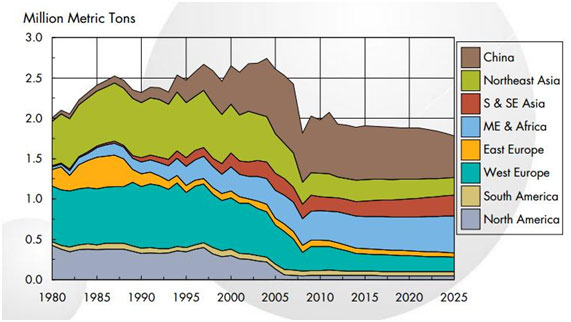TEXTILE FIBER MARKET
Home > Textile fiber market
Currently, polyacrylonitrile is inserted into the textile industry in the form of "acrylic" fibers.
In 2015 alone, world consumption of acrylic fibers was estimated at up to 1.9 million tons.
The region where the largest production of acrylic fibers is concentrated is China accounting for approximately 40% of world production and then Africa and the Middle East with 20%.
Its consumption reached a level of 2.8 million tons per year 2004, but due to competition with polyester fiber there was a reduction of consumption, reaching today approximately 1.9 million tons per year.
Its consumption should remain relatively stable for the next 10 years, as there are few fibers with similar properties and less cost to replace the PAN in its current applications.
 Production and estimation of the acrylic fiber market in the world
Production and estimation of the acrylic fiber market in the world
The largest producing companies in the world, responsible for approximately 50% of the world's capacity, are:
- AKSA Akrilik (Turkey), which has a production capacity of 330,000 T / A. The company has a 19% share in the global acrylic fibers market and 70% in the domestic market.
- Jilin Qifeng Chemical (China), with a capacity of 140,000 T / A, which, by joining investments with the Italian company Italy Montefibre, reached a capacity of 240,000 T / A.
- Dralon (Germany), which has a capacity of 188,000 T / A.
- Aditya Birla Group, which produces the Birlacril brand by Thai Acrylic Fiber Co Ltd, in Thailand, with a capacity of 120,000 T / A
- SPC Sinopec (China) which has a capacity of 113,200 T / A
Other companies whose capacity is less than 100,000 T / A are:
- CNPC (China)
- Companhia Sudamericana de Fibras (SDF) (Peru)
- DOLAN GmbH (Germany)
- Exlan Toyobo Group (Japan)
- Formosa Plastics Corp (Taiwan)
- Indian Acrylics (India)
- Jiangsu Zhongxin Resources Group (China)
- Kaltex (Mexico)
- Kaneka Corporation (Japan)
- Mitsubishi Rayon Group (Japan)
- Pasupati Acrylon (India)
- Polyacryl Iran Corp (Iran)
- Polymir (Belarus)
- SGL Carbon (Ex-Fisipe) (Portugal)
- Industrial Taekwang (Korea)
- Tong-Hwa Synthetic Fiber (Taiwan)
- Toray (Japan)
- Vardhman Acrylics (India)
- Yousuf Dewan (Pakistan)
In Brazil, there were two factories in the past: Companhia Sudamerica de Fibras (SDF), which was located at the Camaçari Petrochemical Complex (BA), that used dry spinning technology from Mitsubishi Rayon; and
Radicifibras in São José dos Campos (SP), which used DuPont's wet spinning technology, having ended its production of the
“Crylor” fiber in 2013.
In all of America there are only two acrylic fiber companies:
Companhia Sudamerica de Fibras (SDF), which is located in Callao, Peru, and
Kaltex, located in Altamira, Mexico.
In relation to the world market for synthetic fibers, which is of the order of 70 million tons per year, dominated mainly by polyester, the share of acrylic fibers is relatively small, but has remained constant over the last decade (in the range of 2 million tons per year), occupying niche applications, where their differentiated properties in relation to polyester and nylon make acrylic fibers advantageous because of its great resistance to degradation by sunlight, thermal insulation, resistance to organic solvents and infusibility, and its similarity to natural fibers, like silk and wool.
 Production and estimation of the acrylic fiber market in the world
Production and estimation of the acrylic fiber market in the world